

How Colleges Should Adapt in a Networked Age - The Chronicle of Higher Education. This is the latest episode of our new podcast series on the future of higher education.

You can subscribe in iTunes, Overcast, or Stitcher. Perhaps you’ve stood in the front of a classroom, looked out on the room full of students distractedly checking email or Facebook, and thought: They’re just not that into this. Back when you were at their desks, you remember being tuned in, more respectful of the professor at the podium. MOOCs aren't 'massive' just because they have lots of people taking them.
2 min read In a VentureBeat article entitled MOOCs no longer massive, still attract millions, the CEO of an online course selection website talks about the 'changing business models' behind Massive Open Online Courses.
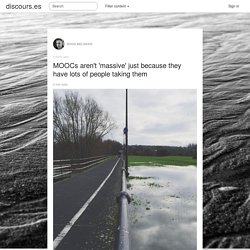
What I think vendors misunderstand, quite apart from the difference between a cMOOC and an xMOOC is that the 'Massive' part of the MOOC acronym isn't related to the actual number of people enrolled on a course. As Stephen Downes helpfully points out in a post from 2012: What Are The Education Soft Skills That Can Change Everything? Online Learning: Why Libraries Could Be the Key to MOOCs’ Success. For all the promises of online courses disrupting education, completion rates are notoriously low.
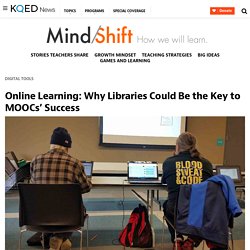
Some studies found that about five percent of those enrolled in massive open online courses (known as MOOCs) completed the course. And those who took the courses tended to be more educated already – 70 percent of survey respondents had bachelors degrees and 39 percent identified as teachers or former teachers. Online courses can be a helpful tool for self-sufficient, highly motivated learners with reliable computers and internet at home, but others may need a little more support. For those who haven’t found success using free online courses, Learning Circles might be an answer. The benefits of non-formal learning.
Educator Louis Debono teaches in both formal and non-formal environments and greatly believes in the benefits and importance of both.

As a teacher at De La Salle Sixth Form, in Malta, he uses formal learning on a daily basis, however he is also a champion for non-formal learning in his roles as a trainer for youth workers and volunteers for the European Volunteer Service, and a human rights trainer within the Council for Europe. Here he shares his experiences. Non-formal learning is a key phrase in our approach to education today. How to increase MOOC completion rates. Dive Brief: St.
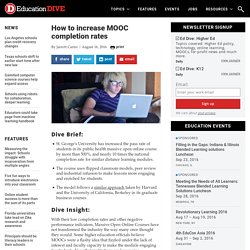
George's University has increased the pass rate of students in its public health massive open online course by more than 500%, and nearly 10 times the national completion rate for similar distance learning modules. The course uses flipped classroom models, peer review and industrial infusion to make lessons more engaging and enriched for students. The model follows a similar approach taken by Harvard and the University of California, Berkeley in its graduate business courses. 5 Ways To Humanize The eLearning Experience - eLearning Industry. eLearning is big.

But how big exactly? According to a recent study, “the number of students taking at least one online course increased by over 570,000 to a new total of 6.7 million”. The Golden Age of Autodidacts. Illustration by Kyle Platts Who can resist the romanticism of self-taught achievers?
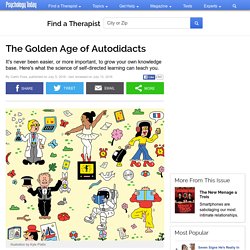
They didn't need school. They didn't need "the system. " They needed only their passion and their talent to propel themselves to grandeur. Bill Gates, college dropout turned billionaire techie and world saver, is the modern apotheosis of the autodidact. How Millennial Attitudes Will Shape The Future Of Education Millennials are now the largest generation in the Canadian workforce, and within the next few years will begin to get real responsibility and influence in shaping our country's future.

With the school year now behind us, it's a great time to think about what the future holds for education in Canada and how millennial attitudes will shape this future. Here are three key trends to watch out for. How Teacher-Created Free Online Resources Are Changing the Classroom. When Eric Langhorst teaches the Civil War to his eighth-graders at Discovery Middle School in Liberty, Missouri, he likes to give his students a taste of what Missouri was like in that era.
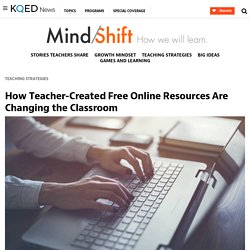
In addition to teaching about the big events found in any Civil War curriculum, like the battles of Gettysburg and Antietam, Langhorst incorporates materials he has created about the guerrilla-style warfare more common in his region at that time. He wouldn’t be able to localize his curriculum that way if he taught only out of a textbook. “Some of the limitations of textbooks are they tend to be very non-interactive, kind of impersonal, and they’re not very flexible in terms of regional differences,” Langhorst said.
For all these reasons, he doesn’t use them anymore. Focusing on 'high-demand' fields is key to tuition assistance programs, Amazon says. Amazon, the dominant force in online shopping, wants its employee tuition assistance program to be the go-to way that corporations help their workers pursue career and technical education.

The retail giant has run its tuition assistance program, known as Career Choice, for about four years. During that time, more than 6,000 employees -- most of them working in Amazon’s many warehouses across the country -- have participated. Earlier this month, Amazon said it will take the program “open source,” meaning it will share with other companies the building blocks of the program for them to “build upon it, tailor it for their own use cases and improve upon it.” Compared to other programs, Career Choice ranks among the more flexible. Once employees have been with Amazon for a year, they only need to cover 5 percent of tuition and fees -- Amazon covers the rest up front and also reimburses 95 percent of textbook costs. Socially Engaged Learning. Key Takeaways Various instructional models for online learning focus on efficiencies of time and space, from flipped classrooms to competency-based education, MOOCs, and online learning environments that rely on reading, writing, and discussion.
The model proposed here for online education focuses on social learning and student engagement, training faculty and designing online courses to make interaction the driving factor in creating a highly personalized experience for students. The model's five-point framework highlights best practices to create a high level of student engagement, with guidance on reading and writing instruction, peer group work, discussion, experiential learning, and assessment. The common online format of read, write, discuss often results in a subpar academic experience.1 Hidden biases within online education can create unintended obstacles for learners, and many of these biases have grown rather than shrunk over time. How Social Media is Reshaping Today's Education System. Join Entrepreneur and today's most influential business innovators in Denver, May 4. Register Now » Are today’s students tweeting their way to better grades?
More than nine out of 10 teenagers hold at least one social media account; Instagram, Snapchat, Tumblr, Vine, Twitter and Facebook rule the lives of most middle and high school students. And while much attention has been paid to the negative effects of social media, including cyber bullying, there could be a positive upside, too. Related: What You Can Learn From 8 Kids Already Making a Million Dollars. Personal Learning Environments and the revolution of Vygotsky’s Zone of Proximal Development. Developmental psychologist Lev Vygotsky defined what the person or a student can do — or the problems they can solve — as three different stages: What a student can do on their own, working independently or without anyone’s help.What the student can do with the help of someone.What it is beyond the student’s reach even if helped by someone else.
He called the second stage the Zone of Proximal Development (ZPD) which had, as said, two limits: the lower limit, which was set by the maximum level of independent performance, and the upper limit, the maximum level of additional responsibility the student can accept with the assistance of an able instructor. But Vygotsky believed that learning shouldn’t follow development, but rather should lead it. What's Next for the LMS? Today's LMS needs to be supplemented with (and perhaps later replaced by) a new digital architecture and new learning components—the NGDLE—to enable current transitions in higher education. Malcolm Brown is Director of the EDUCAUSE Learning Initiative (ELI). Joanne Dehoney is Chief of Staff, EDUCAUSE. Nancy Millichap is Program Officer with Next Generation Learning Challenges (NGLC), EDUCAUSE. The learning management system (LMS) is a remarkable phenomenon in higher education.
On the one hand, the LMS has seen unprecedented adoption rates. On the other hand, restlessness with the LMS is conspicuous. Stackable degrees gaining prominence as entry points to grad school. Dive Brief: The University of Illinois at Urbana-Champaign will soon offer a master’s degree in data science through Coursera, opening its curriculum to students who are interested in the full master’s as well as individual or groups of courses.
The Chronicle of Higher Education reports the “stackable” nature of the degree, in which students can take a few courses, get a certificate, and later apply those courses toward a full master’s program, is expected to become increasingly popular among institutions looking to create more flexible and affordable programs for students. How MOOCs Foil Distraction. Free eBook: 129 Tips on Using Technology in Virtual and Physical Classrooms. 8 higher ed thought leaders share words of wisdom at SXSWedu. Ten Teaching Trends from the Innovating Pedagogy Report - TeachOnline. Lse.ac.uk storage LIBRARY Secondary libfile shared repository Content Livingstone,%20S Livingstone Connected learning agenda 2010 Livingstone Connected learning agenda 2013. Definitions Open/Distance Learning key terms COL.
TIPSFramework QualityAssurance OER COL. 21st Century Citizenship. A Vision for 21st Century Citizenship The ways in which Americans, as citizens, engage in their communities, their country and the world are changing and expanding. The challenges of being a responsible, effective citizen are more diverse, nuanced and complex than in the past. Sustaining our democracy, strengthening economic competitiveness and meeting local, state, national and global challenges demands a broader vision of citizenship for the 21st century. P21 has embarked on a year long project to redefine and reimagine 21st century citizenship, working in partnership with the leading civic learning, global awareness, and digital literacy experts. The 21st Century Citizenship Guide outlines a vision of citizenship that encompasses informed, engaged and active practices in three dimensions of citizenship—civic, global and digital.
Dr. Ruben Puentedura. Prensky 5 The World Needs a New Curriculum. Guiding Students as They Explore, Build & Connect Online-Belshaw. The Future of Higher Education? Ask the Magic-8 Ball! Want to know the future of higher education in this age of disruption? Opening up education through innovation. 2015 Richards Virtual Universities Policy Makers COL. 2015 Butcher Moore Understanding OER. Policy Brief on MOOCs COL. New business of b-schools. The traditional MBA, the flagship of graduate business education for more than a century, is losing ground as applicants increasingly turn to online degrees and specialized master’s programs in business-related fields. Design Patterns for Open Online Teaching and Learning 42 0. Assessment, certification and quality assurance in open learning 40. Digital Literacies and eCompetence ISSUE 38 0. Experience and best practise in and around MOOCs issue 37 0.
Design for Learning Space and Innovative Classrooms - eLPapers Issue34 EN. Learning and Worl EN 31. Five emerging trends for innovative tech in education. No longer simply future-gazing, technologies like augmented and virtual reality (AR/VR) are becoming firmly accepted by the education sector for adding value to learning experiences. CenturyLinkVoice: 5 Tech Trends That Will Transform Education By 2025. The future of Educ - CEO of edX. 7 life skills that tech will make obsolete in 2016. Researchers still grapple with measuring quality in for-credit MOOCs. European Schoolnet - Future Classroom Lab. Planting the seeds for the 702010 learning model in your organisation.
Meet the Robin Hood of Science. Basic Digital Skills Every Teacher Should Have. Sugata Mitra: schools should scrap the 3Rs. A Passport to Global Citizenship Infographic. Revisiting Digital Natives, Digital Immigrants. Collaborative classrooms mark wave of the future in higher ed. 11 Reasons why teachers don't use technology - EnglishUp. We’re Breaking Up: Rebecca Solnit on How Modern Noncommunication Is Changing Our Experience of Time, Solitude, and Communion. Smart robots could soon steal your job - Jan. 15, 2016. 5 Teaching Practices I'm Kicking to the Curb. 5 Ways Digital Tools Are Transforming the Education Space. Is Education Technology Losing Its Humanity? Four Inventive Games That Show Us the Future of Learning. 27 Ways to Inspire Students to Innovate.
Silicon Valley wants to reinvent school. If you can Google it, why teach it? Is Education Technology Losing Its Humanity? Mobile is Changing Everything, and Education is no Exception. 5 signs your K-12 LMS needs an upgrade. A Decade Ago, The Chronicle Envisioned Higher Education in 2015. How’d We Do? Pens are dead. Paper is dead. Handwriting is a relic. 5 gray areas of higher education’s reinvention.
5 higher ed trends to watch in 2016. Developing digital literacies. 6 Expert Predictions for Digital Education in 2016. Five Ways Online Learning is Enabling Change in Post-Secondary Education. Students Aren't Coddled. They're Defeated. 5 Tech Trends that Could Supercharge Education in 2016. How Facebook Plans to Disrupt Education. The Future of Higher Education? Ask the Magic-8 Ball! 3 Ways Exponential Technologies Are Impacting the Future of Learning.
The Connected School: How IoT Could Impact Education. Clay Shirkey-The digital revolution in higher education has already happened. No one noticed. Man behind 'MOOC' not impressed by disruption narrative. Context Is King: Why Today's MOOCs Don't Meet Corporate Needs. What Drone Technology Can Teach Students. Infographic. What Drone Technology Can Teach Students. BYOD in the Secondary Classroom: Necessary or Nice? How Would Today’s Smartest Teens Overhaul Education? We Asked Them. Rethinking the Role of Educator as Facilitator Amidst Tech Transformation. This Is What Students Will Be Doing in 2035 — Bright. Opening up education through innovation. Modern Learners - Bruce Dixon and Will Richardson.
Schools of the future. 25 Ways Teachers Can Integrate Social Media Into Education. Top Ed-Tech Trends of 2015. Student Centered Instructional Methods. The Online College Revolution Infographic. Future Opportunities With Tertiary Education Infographic.